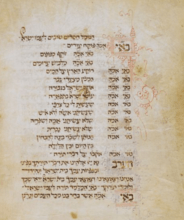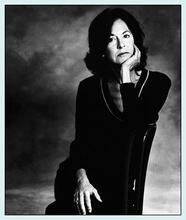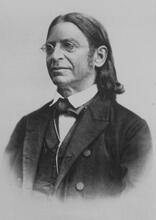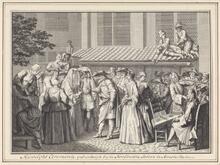Glueckel of Hameln
Businesswoman and memoir-writer Glückel of Hameln was born to affluent family in Hamburg, Germany. She married young and had fourteen children, twelve of whom survived past infancy. Glückel was an active partner in her husband’s business and managed the business after his death in 1689. She began writing memoirs in 1691 to help her own mental state and educate her children about their family history. These memoirs are incredibly detailed, combining a meticulous record of her life and descriptions of events that occurred in local Jewish communities during that period. Her memoirs are both a singularly important social and historical document and one of the greatest literary achievements of Ashkenazi prose–in Yiddish or Hebrew–at least until the end of the eighteenth century.
Marriage and Family Life
Glückel, author of an untitled memoir in Yiddish that is the source of most of the information about her life (with the exception of the date of her death and several minor details), was born in Hamburg to an affluent family of merchants with commercial and familial ties to the court Jews and their surrounding circles. When she was twelve years old, her parents betrothed her to Hayyim Hamel, whom she married at the age of fourteen, moving into his parents’ home in Hamel. After their first year of marriage, the couple lived with Glückel’s parents in Hamburg, where their first daughter was born shortly before they moved into their own home. In the course of thirty years of marriage, Glückel gave birth to fourteen children, two of whom—a two-week-old infant and a daughter aged three—died. Throughout the years, Glückel was also an active partner in her husband’s business, which consisted mainly of trading in jewelry and precious stones and, to a lesser degree, money-lending and financial transactions. Not only was she frequently asked for her advice and opinion, but she herself interviewed agents, considered potential business partners, drew up partnership agreements, kept books, and was at the same time busy bearing, raising, and educating her children, looking for suitable matches and dowries for those that reached the proper age, and supervising a large and wealthy household. She appears to have been an active and equal partner in all decisions concerning both family affairs and business matters. As a result, when her husband was asked on his deathbed whether he wished to leave any final advice, he replied: “I have no instructions. My wife, she knows everything. Let her do as she has done until now.”
Following her husband’s death in 1689, with eight of her children still unmarried and living at home, Glückel continued single-handedly to manage the family’s business affairs in Hamburg (where she also opened a sock factory) and at the trade fairs she attended in other cities. After eleven years of widowhood (during which she rejected many offers of marriage) and after marrying off all her children except for her youngest daughter, Glückel married a banker, Cerf (Hertz) Levy of Metz, and moved to Metz. The financial status of her second husband—to whom she had entrusted all her money and even her daughter’s dowry—gradually deteriorated to the point of bankruptcy, and when he died in 1711 Glückel was left penniless. She was forced to spend her final years dependent on her daughter and son-in-law in Metz and living under their roof—a situation she had always feared and worked throughout her life to avoid.
Memoir-Writing
Glückel began writing her memoirs in 1691 at the age of forty-six, about two years after the death of her first husband, in order to “stifle and banish the melancholic thoughts which came to [her] during many sleepless nights,” and convey to her children and their descendants the life stories of their parents and family. We do not know when she decided to compose her book in seven chapters (which she referred to as “books”), but it was at an early stage that she determined to begin with her birth. However, the first chapter is an introduction to her spiritual world, a kind of manifesto of the faith, belief, aspirations, motives and opinions of this God-fearing pious Jewish woman, dealing mainly with these and other topics from the field of musar (moral and ethical teachings).
Though the second chapter begins with her birth, there is almost no reference to her childhood and upbringing save for the fact that she studied in a Lit. "room." Old-style Jewish elementary school.heder and that her father saw to it that his children, male and female alike, receive an education “in both religious and secular matters.” The subject matter of this chapter consists mainly of family occurrences (only rarely witnessed by herself), events in the congregation of Hamburg-Altona, and the figures of her direct ancestors. In dealing with these topics, she often shifts to the past, two or three generations before her birth, touches on the foundation and history of the kehillah (community) into which she was born, and moves from her direct ancestors to other personalities related to them or to their community before she turns nearer to the present for an orderly outline of her husband’s family and a concluding statement: “My dear children, I write you this in case today or tomorrow your children or grandchildren do not know about their family. I have put it down briefly so that you may know from what kind of people you are descended.” Glückel appears as a distinct personality with her own self-awareness only following her marriage, and even more so with the young family’s move to a separate residence, of which she speaks at the end of the second chapter.
In the third chapter, Glückel offers a detailed portrait of the servants, agents and partners in the family business and of various incidents related to them. She moves on from there to a description of a long chain of events, incidents and episodes she selects from her memories of the period preceding her husband’s death, which make up the third and fourth chapters of her work.
The fifth chapter is devoted mainly to a meticulous account of the illness and death of her husband Hayyim Hamel and its immediate aftermath, followed by a description of episodes from her further life and her deeds and actions for the sake of the family’s livelihood and her children’s future.
The last two chapters deal with her later years. The sixth was written after Glückel’s remarriage and the seventh after she w,as widowed a second time. They open with her preparations for her second marriage and her move to Metz and register episodes of her life there with her second husband, his economic ruin, his death and the events that befell her afterward. The work ends, for no apparent reason, with a reference to an event that took place in 1719, five years before the author’s death.
Themes and Content of Glückel’s Memoirs
Glückel’s work is far more than a family chronicle. It abounds in descriptions of events that occurred in the Jewish community of Hamburg-Altona (such as the reaction to word of the imminent coming of the Messiah, Shabbetai Zevi, and the murder of two local Jews), in her adopted community of Metz (for example, the tragedy that took place in the synagogue on the holiday of Lit. "weeks." A one-day festival (two days outside Israel) held on the 6th day of the Hebrew month of Sivan (50 days, or 7 complete weeks, from the first day of Passover) to commemorate the Giving of the Torah on Mount Sinai; Pentecost; "Festival of the First Fruits"; "Festival of the Giving of the Torah"; Azeret (solemn assembly).Shavuot, or the fierce dispute there concerning the rabbinate), and sometimes even in distant communities (the diamond theft carried out in Norway by two Jews from Hamburg). A considerable number of the events recorded in her work take place not in her home or immediate surroundings but in other places and communities both within Germany (such as Berlin, Frankfurt, Hanover) and abroad (such as Amsterdam and Copenhagen), in one of the many locations she visited in order to call on relatives or friends, to negotiate, arrange, or celebrate the marriages of her children, to do some business on her own, or to assist her husband in his trade. Also mentioned in her writings are events in Jewish communities in Poland (Vilna and Lissa [Lesznol]), general historical events (mainly wars) in Germany and France, and so forth. Glückel’s perspective, which constantly fluctuates between the private and public spheres, offers a sweeping glimpse into the life of the period and its people, including a rich gallery of contemporary women.
The language of Glückel’s writing—Old Yiddish, or Western Yiddish—is particularly rich in Hebrew elements and includes numerous quotations from the Hebrew scriptures. Consequently, one might assume that the author was fluent in Hebrew and had a thorough grasp of texts in that language; but closer examination indicates that this was not the case (thus, for example, Glückel requires a Yiddish interpreter to understand a Hebrew text). Her impressive knowledge stems from her traditional education, from her intense and judicious attention to the oral culture of her immediate environment, which did not lack for learned men and religious scholars, and from extensive reading of works in Yiddish, in particular stories, drawn from both Jewish and non-Jewish sources, and works of musar. From these sources she drew not only the dozens of tales, legends, parables, and proverbs she intertwined in her text for the sake of illustration and concretization, but also the foundations of her worldview, the modes of expressing it, and the various styles of her writing. At the same time, her work offers proof of original thinking, inventiveness, and an impressive capacity for self-expression on the part of a woman who examines her past with wisdom and sensitivity and produces a fascinating portrait of her life, the life of her family, and the life of her times.
On the one hand, her memoirs offer a multi-perspective portrait of an entire society: daily life and its conduct, customs and practices; family life; women and their role; child-rearing and education; commercial, economic and spiritual life; beliefs and opinions; relations between Jews and non-Jews, and much more. Yet at the same time, her work introduces us to the writer’s own personality, to her inner world, to the development of her self-awareness. Her powers of observation allow us to accompany her through joy and pain; to see her in times of crisis, conflict and despair, but also at moments of acceptance, fulfillment, and satisfaction; to catch a glimpse, be it of her sense of humor and irony, or of her sheer pleasure at the act of writing. Not surprisingly, Glückel’s memoirs are considered both a singularly important social and historical document and one of the greatest literary achievements of Ashkenazi prose—in Yiddish or Hebrew—at least until the end of the eighteenth century. Glückel’s writing, a fascinating mosaic of varied genres, bears the unmistakable imprint of contemporary Yiddish literature in its eclectic approach—meshing form, substance, and methods from a range of sources with musar literature and homiletic prose, assorted aspects of folk literature, the heartfelt tone of the tkhines (prayers of supplication), and the immediacy of reports on current events. It seems, however, that the literature available to her did not offer any model of autobiographical writing and she herself did not know how to categorize her genre. Although she dedicates her words explicitly to her children, there are various indications that she was writing with an eye towards other readers as well. On more than one occasion, her desire to adhere to the chronological order of events clashes with the associative stream of her recollections at the time of writing; as a result, later events are often presented before earlier ones, and vice versa.
Print and Preservation of Memoirs
The original text in Glückel’s handwriting has not been preserved, but at least two copies were made: one by her son Moshe and another by her grandson Hayyim. The two copies were passed down within the family from generation to generation, eventually finding their way in the late nineteenth century to the scholar David Kaufmann (1852–1899), who published the memoirs in 1896. Since then, one of the copies has been lost, although it is possible that a small four-leaf folder in the National Library of Israel in Jerusalem is a section of it. (The other copy is preserved at the Municipal and University Library of Frankfurt am Main.)
Glückel’s work is known mainly in translation, since the original was never reprinted, and its language, Old Yiddish, was no longer understood by the general public even at the time of its publication by Kaufmann. The first translation was rendered into German by a relative of Glückel’s, Bertha Pappenheim (who also posed as Glückel for a portrait painted by the artist Leopold Pilichowski [1869–1933]), but this translation was at the time intended only for the family. A subsequent annotated translation into German by Alfred Feilchenfeld emphasized biographical and historical events (to which he appended numerous important glosses), but omitted the author’s reflections, along with many of her introspective contemplations and most of the stories she wove into her writing (only three of which appear in an appendix at the end of the book). Feilchenfeld’s translation served as the basis for Marvin Lowenthal’s translation into English, which was later followed by translations into French, Italian, and Hebrew. The translations that are for the most part faithful to the original Yiddish include the following: the translation into English by Beth-Zion Abrahams; into Hebrew, by Alexander Siskind Rabinovitz; into modern Yiddish, by Dr. Joseph Bernfeld; and into Dutch, by Mira Rafalowicz. A translation into Russian is known to have appeared recently, but its quality has not yet been verified.
Glückel’s work was enthusiastically acclaimed especially after it appeared in Feilchenfeld’s German translation and has since then served many scholars as historical source for their specific studies in numerous and diverse topics. But it is only since the last two decades of the twentieth century, due to the growing scholarly interest in autobiography and the development of gender studies, that the work itself as well as its author have become the object of serious academic research.
Bilik, Dorothy. “The Memoirs of Glikl of Hameln: The Archaeology of the Text.” Yiddish 8/2 (1992): 5–22.
Davis, Natalie Zemon. “Arguing with God: Glikl bas Judah Leib.” In Women on the Margins: Three Seventeenth-Century Lives, 5–62 (plus notes, 220–259). Cambridge-London: 1995.
Idem. “Riches and Dangers: Glikl bas Judah Leib on Court Jews.” From Court Jews to the Rothschilds: Art, Patronage and Power, 1600–1800, edited by Vivian B. Mann and Richard I. Cohen, 45–57. Munich-New York: 1996.
Hummel, Hildegard. “Die ‘Memoiren’ der Glückel von Hameln, Das Schicksal einer jüdischen Frau um die Wende des 17. Jahrhunderts.” Jüdinnen zwischen Tradition und Emanzipation. Jahrbuch des Archivs Bibliographia Judaica 2/3 (1986–1987). Frankfurt am Main: 1990.
Minkoff, N. B. Glickel Hamel (1645–1724) (Yiddish). New York: 1952.
Pollock, George H. "Glückel Von Hameln: Bertha Pappenheim's Idealized Ancestor." American Imago 28, no. 3 (1971): 216-27
Richarz, Monika, ed. Die Hamburger Kauffrau Glikl: Jüdische Existenz in der Frühen Neuzeit. Hamburg: 2001. Collection of articles based on lectures from a conference in Hamburg devoted to Glückel and her era, marking the 350th anniversary of her birth. The footnotes accompanying the articles contain a wealth of bibliographical references.
Turniansky, Chava. “Descriptions of Events in Glikl Hamel’s Memoirs” (Yiddish). Die Goldene Keyt 134 (1992): 35–40.
Turniansky, Chava. “Descriptions of Events in Glikl Hamel’s Memoirs” (Yiddish). Die Goldene Keyt 134 (1992): 35–40.
Idem. “The Stories in the Memoirs of Glückel of Hameln and Their Sources” (Hebrew). Jerusalem Studies in Jewish Folklore 16 (1994): 41–66.
Idem. “To What Literary Genre Does Glikl Hamel’s Work Belong?” (Yiddish). Proceedings of the Eleventh World Congress of Jewish Studies, sect. C, vol. 3, Jerusalem: 1994, 283–290.
Idem. “A Jewish Woman’s Life: The Memoirs of Glikl (Hamel)” (Hebrew). In Sexuality and the Family in History, edited by Israel Bartal and Isaiah Gafni, 177–192. Jerusalem: 1998.
Idem. “The Hebrew Component in Glikl’s work as Evidence of Her Education” (Yiddish). Röllwagenbüchlein: Festschrift für Walther Röll zum 65. Geburtstag. Edited by Jürgen Jährling, Uwe Mewes, and Erika Timm, 433–441. Tübingen: 2002.













